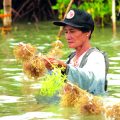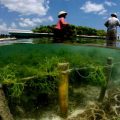The Department of Agriculture (DA) is eyeing to boost seaweed production in Southern Leyte to maximize seaweed’s niche to give jobs to highly-skilled seaweed growers and eradicate poverty in potential coastal areas.
The project should harness the already existing Philippine asset as a producer of United States-Food and Drug Administration-approved Philippine Natural Grade (PNG) carrageenan, a product made from seaweed.

Carrageenan, according to producer MCPI, is a “hydrocolloid” (gel in contact with water) extracted from red seaweeds which employs a nature-friendly low-energy mild alkali process.
“We are looking into supporting more projects in seaweeds since it is a product that is unique to us and where we can have the competitive edge globally,” said DA-Bureau of Agricultural Research (BAR) Director Nicomedes P. Eleazar.
A P5 million financing is proposed by the Bureau of Fisheries and Aquatic Resources (BFAR) for farming of seaweeds in Hinonangan, Southern Leyte.
The project proposes a P5 million funding from BAR.
The use of carrageenan over other substitutes is even more becoming a global trend considering its environment-friendly manufacturing.
“If possible, we want to plant seaweeds in all suitable areas in Leyte so that we can contribute to elimination of pollutants. Seaweeds utilize excess organic matter (in the environment). It’s a plant that functions to filter natural waste in the environment,” said Lea Tumabiene, officer-in-charge of BFAR extension communication and training division.
BFAR Region 8 headed by Dr. Juan D. Albaladejo, director, aims to provide seedlings and other inputs for beneficiaries. Perhaps more important, the BAR-BFAR project is considering to aid farmers particularly in producing high-quality seeds since a market is ready to buy the products.
Strict export- quality standards
If seaweed production in Southern Leyte will increase, the TBK Manufacturing Corp. can buy the products. However, the company is very strict in quality and obtains most of its supply from an even more distant source, Zamboanga, even if Leyte’s potential production is significant.
TBK, a PNG carrageenan producer and exporter, has a Hazard Analysis Critical Control Point (HACCP) certification, a globally-recognized food safety system, which consequently compels it to keep strict quality.
The country exports seaweeds to the United States and Europe, among others.
According to the Seaweed Industry Association of the Philippines (SIAP), the country held as of 2003 the number one global position in semi-refined food grade carrageenan, alkali treated chips, and raw dried seaweed. It ranked fourth in refined carrageenan.
Potential huge dollar earnings
This was equivalent to close to $200 million in export earnings including $87 million for semi-refined carrageenan, $41 million for refined carrageenan, and $15 million for raw dried seaweed.
Given government support, dollar revenue generation from the sector may reach to $500 million to $1 billion yearly.
That is aside from its important job creation role.
“Over a million marginal fishermen are engaged in seaweed farming with an average annual income of P120,000.00,” according to SIAP.
According to Cebu-based carrageenan manufacturer MCPI, the Philippines over the last two decades has been dominating the raw material (seaweed) supply globally, accounting for 70 to 75 percent.
MCPI said this is attributable to “the unique blending of the country’s coral reef structure, temperature and currents of its waters, and the accessibility of easily-trained workers.”
The country can take much of this needed expansion from Southern Leyte. A total of 40 species of macrobenthic algae was identified in Southern Leyte, according to Southern Leyte State University.
. This is composed of 17 species of green algae,13 species of brown algae, and 10 species of red algae.
At present, seaweed farmers need extensive financing for seedlings, farm devices, and for daily sustenance. BFAR only extends to them free seedlings when it conducts technology demonstration.
But the needed skills in growing are already well-provided by the province’s residents.
Seaweed growing best practices
When BFAR conducted a participatory rural appraisal (PRA), they found out Southern Leyte coastal natives already have best practices in seaweed farming.
“When it’s not seaweed season, they keep their culture lines and tie them in an anchor under the sea, so these are not carried away by waves and rains. They also preserve their seedlings,” said Tumabiene.
They also practice economical growing through the floating system.
The farmers in Southern Leyte, still considered to be living in an identified poverty-stricken area, still lack financing. There aren’t a lot of financing windows there, and farmers turn to BFAR for this help.
“BFAR’s financing is not enough. Farmers need to expand over a bigger seaweed area because the conversion to carrageenan requires a bigger area. The ratio of fresh seaweed to dried is seven to one.”
The other problem is the infestation of turtles. One time they planted up to 2,000 kilos of seedlings, but these all were destroyed by sea turtles. The area is a spawning ground for turtles.
BFAR is finding a way to install turtle scarers in seaweed farms, perhaps noise-making devices to shoo the creatures a way.
Southern Leyte as the next Zamboanga
Southern Leyte and perhaps other Eastern Visayas sites have a significant potential to become a major seaweed source in the country just like Zamboanga as its residents are willing to go into aggressive planting.
In Brgy Maliwaliw, Eastern Samar, farmers assiduously clean their farms. Because of their sanitation practice, they are able to stay away from diseases and are therefore able to harvest seaweeds on a daily basis.
If the plants become heavy with growth, they prune the outgrown thalli (branches) so that the thalli are able to branch out some more. They dry under the sun the harvested mature thalli, while new offshoots may also be used as seedlings. They use monofilament (tansi or hook and line fishing) as their culture line for growing seaweeds.
Yield of seaweeds vary depending on the area.
Seaweeds are grown afloat oceans in order to capture photosynthesis. When these are in the bottom of the sea, they can hardly grasp sunlight. Some seaweed growers though particularly in Dawahon River between Cebu and Leyte practice fixed bottom line growing. But this is because coral reef area is shallow.
Poverty alleviation tool
“It will really help in poverty alleviation. It is especially suitable in coastal areas like ours because seaweed needs a specific location, unlike livestock raising, chicken or hog production which can be done anywhere,” she said.
Southern Leyte should really tap its sea resources since it can be among its single biggest asset in food production.
“Only a few of our municipalities (in Leyte) are without water, and we should use all of these,” she said.
There are already collaborative agreements under a MOA (memorandum of agreement) between local government units (LGU) and farmers on seaweed growing since LGUs have the jurisdiction over coastal water. They are in the best position to collect data and monitor seaweed farming activities being right where the sites are.
World class-grade carrageenan
The Philippines obtained in 1994 an approval for its PNG carrageenan from the Coded Committee on Food Additives and Contaminants) in Rome which conducted toxicological assessment of the food additive.
A Codex Alimentarius food safety certification has also been assigned to the Philippine product.
There is a very extensive market for seaweeds as carrageenan is used as toothpaste binder, choco milk stabilizer, surimi and petfood binder, dessert gel binder, hotdog and sausage binder, butter and fat replacement, bread and pasta binder, textile paint thickener, ham and patty binder, ice cream stabilizer, milk and juice products viscosifier, beer and vinegar clarifier, culture media gelling agent, and frozen and poultry water binder.
The eucheuma, and cottonnii and spinosum species (used for natural grade carrageenan) and particularly the red seaweeds, producing the kappa and iota types, are indigenous to the country.
###
For any questions, please contact Ms. Lea Tumabiene, BFAR extension OIC; for interview requests, 0920-715-7186





